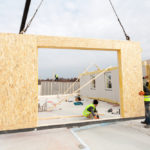News - Construction News
Sustainable construction trends in 2023

Sustainable construction trends to look out for in 2023, and why you need to get ahead of the curve.
Ensuring you are doing everything in your power to keep your business ahead of the latest industry trends has always been a key determinant of success, especially when considering the challenges imposed upon the construction industry throughout 2022 – from the cost-of-living crisis, to extravagant energy costs, material shortages, delays, and more. Looking forward to the remainder of 2023, however, the immediate future of the industry does look promising, with construction expected to grow to a value of $10.5 trillion at a compound annual growth rate (CAGR) of 4.2% by the end of the year. The main driver of this growth? Sustainable construction.
The construction industry as a whole has placed sustainability at the heart of its operations, in line with the UK government’s commitment to becoming a net-zero economy by 2050, and as is often the case, businesses who fail to follow in these footsteps and fail to sufficiently invest will be left at a severe disadvantage. Yet, with what appears to be an endless way of incorporating sustainability into your brand, where do you begin? To help provide a push in the right direction, Sarah Kauter, Managing Director of Construction PR, has shared her insight into what look to be some of the most promising ‘green’ trends to look out for this year.
Trends to look out for in 2023
1.Green building and net-zero design
In line with the government’s net-zero strategy, an estimated £90 billion is expected to be invested across the green building sector by the end of the decade, providing businesses with the support and reassurance they need to reinforce this transition to a low-carbon economy. Since its introduction in October 2021, £26 billion has already been committed, creating 56,000 new jobs across the same timeframe – a figure expected to reach 440,000 by 2030, and something which the construction industry desperately needs.
Especially within recent years, greater pressure is being placed upon developers to conform to the changing demands of an increasing number of environmentally-conscious customers. From switching to eco-friendly materials, to locally sourcing what materials are used, incorporating renewable energy into the design of the home, and more, placing sustainability and ‘green’ building at the heart of your activities will be a key determinant of success for the decades to come.
2. Modular building
Modular design has enabled the construction industry to shift a number of key stages of the building process off-site – something which not only proved essential in remaining productive and operational throughout the pandemic, but also plays a significant role in bringing the industry closer towards a sustainable future. By reducing waste and emissions which would otherwise be generated on-site through transportation and inefficient generators, for example, the global market for modular building is positioned to become one of the more popular approaches to the building industry, with it expected to reach $157 billion in value by the end of 2023.
3. Ground Source Heat Pumps (GSHPs) and geothermal energy
Primarily used within domestic heating systems, GSHPs extract heat energy from geothermal reservoirs located within the earth’s core. The upsurge in sustainable construction has seen geothermal energy skyrocket in popularity within the renewable energy scene, and when considering the ban on new gas boiler installations coming into play in 2025, this doesn’t look to slow down anytime soon. With an estimated 19 million geothermally-powered boilers expected to be installed by 2050, if this is a sector in which your company operates, ensuring you and your team are well-versed in their installation will be essential for decades to come.
4. Living Materials
Living building materials are materials made from microorganisms that are used across the construction and building industries that resemble the characteristics of a living organism; in ideal conditions, these materials can self-replicate, repair cracks and damage, absorb carbon emissions, and even reproduce. A relatively new innovation, yet living materials are already applied across a number of aspects of the construction industry. Calcifying bacteria, for example, is often used to enhance the durability of concrete, whilst mycelium-based composites replicate the characteristics of timber, foam, and plastic insulation within property development.
Advancements within this sector are still in their early stages, and whilst living materials do look to be effective both long-term and on a larger scale, further innovation does remain necessary to increase their financial viability, whilst also finetuning their environmentally-supportive properties. Regardless, advancements in this area are certainly something to monitor, as living materials look to not only play a significant role in reaching net-zero, but also have the potential to change the course of the construction industry as a whole.
If you would like to read more stories like this, then please click here
Related Articles
More News
- Building the next generation
17 Jul 25
We are facing a skills crossroads in our industry, says Richard Martin, Managing Director, Churngold
- Plan to kickstart onshore wind revolution
17 Jul 25
Onshore wind is set to accelerate over the second half of the decade.
- Homes England supports Greencore Homes with new sustainable homes
16 Jul 25
Homes England will provide funding to support the delivery of Milton Heights.






